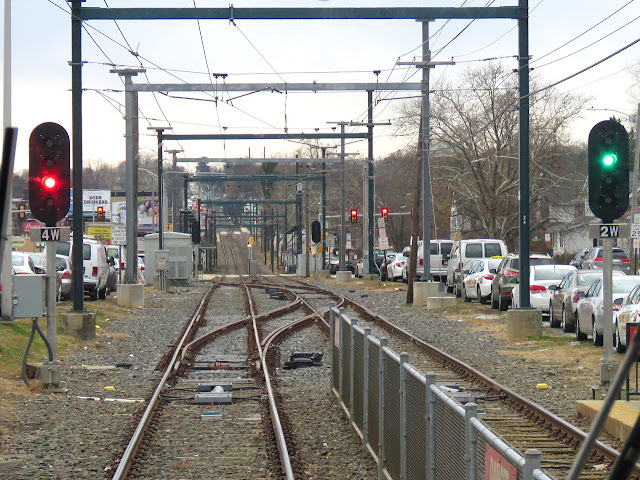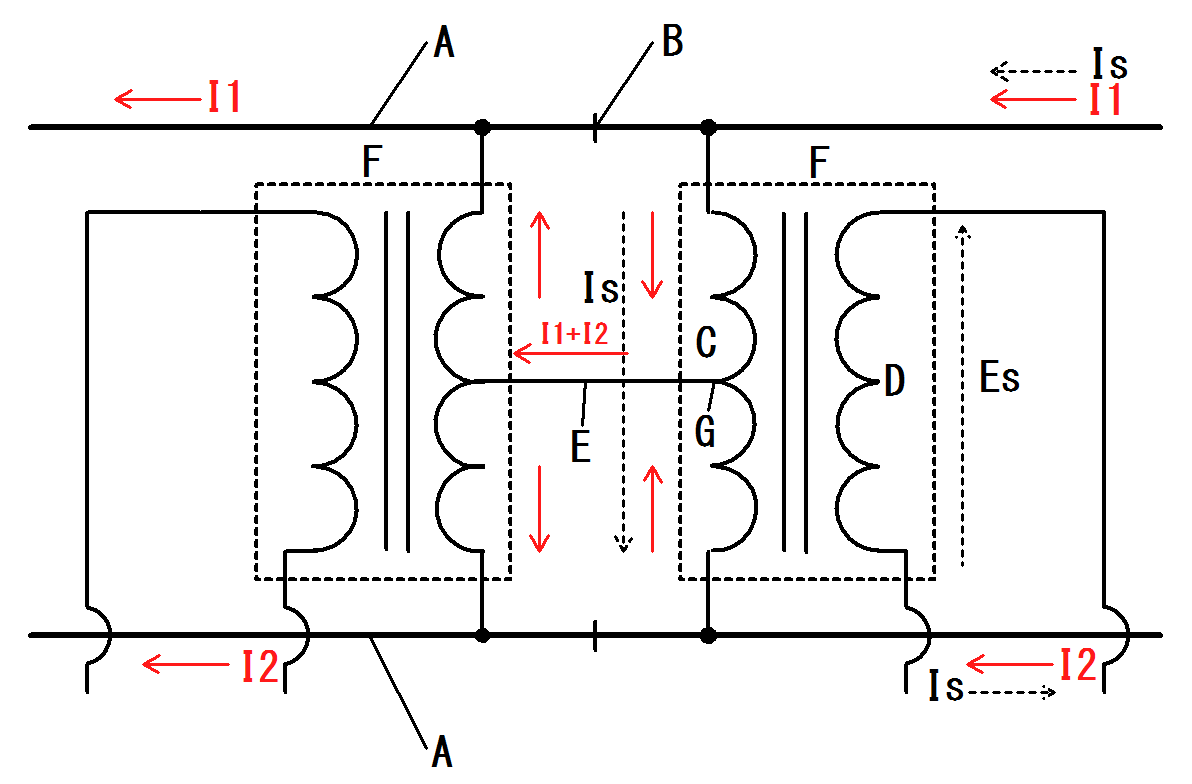Light rail is currently the locus of signaling innovation in North America due to its mix of limited regulation, low budgets and legacy systems. For example I have previously written about DART's three different signaling methods in use on its light rail network. In Philadelphia, one such legacy system is the suburban trolley lines running out of 69th Street terminal on the western Philadelphia border. Similar to Pittsburgh's south hills light rail lines in concept, the method of operation is currently being converted from a basic trolley era ABS system, to a hybrid CBTC system. As I just managed to pick up a bunch of new photos, I figured it was a good time to cover both systems while they are still in the transition period.
 |
| Route 101/102 block signals at 69th St |
The ABS system inherited by and later updated by SEPTA as necessary, was a 2-block affair with signals displaying proceed (green) or stop (red). Although there was one location, Drexel Hill Jct, that could be described as an interlocking with full signal protection and a power operated facing point switch, the entirety of the Routes 101 (Media) and 102 (Sharon Hill) were run under traditional ABS rules with hand throw crossovers and spring switches entering sections of single track.
 |
| Two aspect ABS signals at a Route 101 hand throw crossover including operator hut. |
The single track segments were handled with an automatic tumbledown scheme and the one junction was fitted with a three lamp signal and a route selection punch box. Where a diverging move was encountered a yellow signal indication would be displayed. There was also no ATS or ATC enforcement of signals or speeds.
 |
| Legacy yellow diverging aspect at east end of Route 101 single track segment. |
Due to the sections of street running and close spacing of stops, the Suburban trolley LRV's are considered to have sufficient braking performance to dispense with an Approach type indication. Signals are approached prepared to stop and when the next block is cleared, the following movement will get a clear signal to proceed. Not all of the route miles are protected by signal indication with the street running and other slow areas working on sight. These sections are partly defined by "end of block" signs.
 |
| Route 102 switch protection signal paired with a single track block entrance signal. |
In addition to the two lamp ABS signals, there are/were switch position indicators and reverse direction protection for the single track sections and Drexel Hill Jct. When entering single track and exit signal would follow the spring switch to protect against a race condition if two opposing trolleys were to attempt to "seize" the single block at the same time.
 |
| Route 101 single track switch signal with block entrance signal in distance. |
Starting in 2019 work started on a new CBTC based signal system that would also make use of sizable number of interlockings to replace hand throw crossovers and single track spring switches. As of early 2022 the CBTC system had not yet entered service so the interlockings were used to supplement the existing ABS signal system.
 |
| New SEPTA Suburban Trolley cab display unit with CBTC disengaged. |
In fact on the combined section between 69th St and Drexel Hill Jct there were sufficient interlocked crossovers to supplant all of the ABS signal locations! As many of the ABS block signals have so far remained on the routes past Drexel Hill Jct during the transition period, it is anticipated that the CBTC will provide full block separation, not just a safety overlay.
 |
| New Route 101/102 combined trunk interlocked crossover and block section signal. |
All in all the project involved the addition of 10(!) new interlockings, three crossovers on the combined Rt 101/102 trunk, Drexel Hill Jct, one crossover on each Rt 101/102 branch, three Route 101 single track endpoints and one Route 102 single track endpoint. In addition to these interlockings, three additional holdout signal locations were installed in proximity to an interlocking.
 |
| New interlocked holdout signal at entrance to Rt 101 single track territory to accommodate short turns |
Another interesting new feature is the provision of a yellow fixed ATS transponder adjacent to each fixed absolute signal.
 |
| Yellow ATS transponder located between mast base and rail. |
Although I was unable to observe every detail of the current operation it appeared that the new wayside interlocking signals were backwards compatible with the old ABS system displaying R - Stop, G - Clear, Y -Diverge. The presence of a 4th lamp hints at at the presence of a lunar white indication that will either be used for a "cab speed" (most likely) or an absolute block / restricting signal.
 |
| Same location as above prior to rebuild with spring switch and yellow "end of block" sign indicating start of line of sight operations. |
Although the new CBTC/CTC system is modern and high tech, it never the less exhibits the limits of technology to deliver substantive performance gains. Ten new interlockings along with 20 or so miles of CBTC will cost more to maintain than the legacy ABS system. Furthermore, the speed control function will almost certainly decrease performance from current standards. On the other hand contingency operations will be greatly improved with track work becoming possible during operating hours and vehicle/overhead line failures now able to be worked around without the need for temporary block operators hand throwing switches. In theory the capacity of the system will improve, especially on the route 101/102 combined trunk, however the decision to run more frequent service has always been limited by the budgets and political will of both SEPTA and various levels of government. My assessment is that operations will say the same, liability will decrease along with speed and the impact/cost of contingency operations will decrease enough to offset the high cost of the new signaling system, at least until the point that the technology becomes unreliable.


























